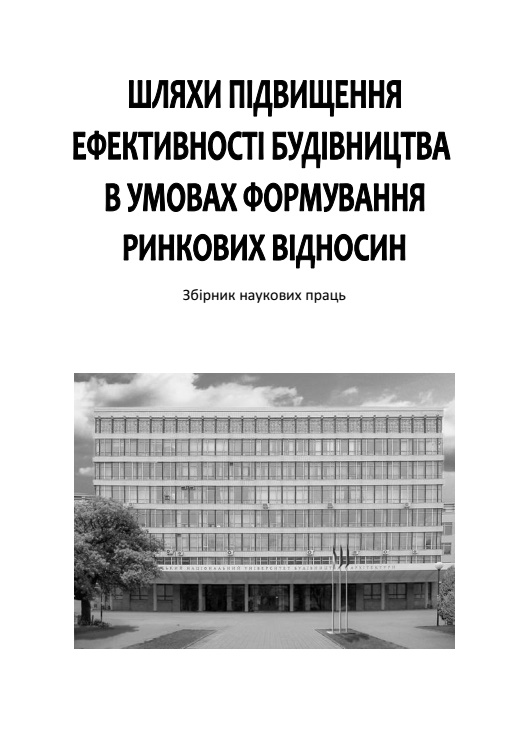Trends in modern construction
DOI:
https://doi.org/10.32347/2707-501x.2022.49(1).1-15Keywords:
efficiency of construction, thermal modernization of buildings, combined, combined and monolithic construction, reconstruction of buildingsAbstract
The article highlights the results of analysis and systematization of certain trends in the development of modern construction in Europe and Ukraine. It is indicated on the main directions of increasing the efficiency of investments in construction due to the improvement of structural and organizational and technological solutions.
It was established that one of the priority areas in construction is construction processes aimed at improving the thermal protective properties of buildings, namely, the device for heat insulation of external enclosing structures of walls, roofs, windows, and external doors. This area is key in domestic and European construction. According to statistics, more than 75% of existing civil buildings in Europe and more than 90% in Ukraine do not meet modern standards for energy conservation.
The next direction of development of construction technologies indicates the introduction of prefabricated and prefabricated monolithic structures. The direction in construction, which was recently dominant in our country and over time partially neglected, is reviving again at a rapid pace, both in Europe and in Ukraine. Full-assembly and prefabricated monolithic structures and technologies make it possible to carry out relatively simple technological processes of erecting buildings on a construction site with structures of high factory readiness. This reduces the labor intensity of construction processes, improves the quality of work and does not require a high level of qualification of individual construction professions, such as an installer.
One of the important areas of modern construction is the reconstruction of existing buildings and territories. The reconstruction of civilian buildings is aimed at restoring the operational properties of existing buildings with a possible superstructure, extension, reconstruction and their mandatory thermal modernization. These processes include disassembly of the roofs of low-rise buildings with their subsequent superstructure, extension of balconies, improvement of adjacent areas. These activities are aimed at extending the time frame and improving the conditions for the further operation of buildings. Also, the scope of work on the reconstruction of industrial buildings and territories for objects for civil, socio-cultural purposes, that is, their revitalization, is constantly expanding.
References
ДБН В.2.6-31:2016. Теплова ізоляція будівель. [На заміну ДБН В.2.6-31:2006; чинний від 2017-04-01]. Вид. офіц. Київ: Мінрегіон України, 2017. 37 с.
GebäudeEnergieGesetz (GEG) – PDF. URL: https://www.chip.de/downloads/GebaeudeEnergieGesetz-GEG-PDF_183083767.html
Савйовський В.В. Термомодернізація будівель: навч. посіб. Київ: Видавництво Ліра-К, 2021. 278 с.
Савйовський В.В. Аналіз та впровадження передового досвіду – запорука ефективності будівництва. Будівельне виробництво. 2019. № 67. С. 66-72. doi: https://doi.org/10.36750/2524-2555.67.66-72
Meier Heinz-H. Sachverständiger für Schäden an Gebäuden. URL: https://www.modal.de/wissensdatenbank/sachverstaendiger-fuer-schaeden-an-gebaeuden/
Saviovskyi V. Instandsetzung von Gebäuden und Bauwerken. Verlag: BoD-Books on Demand, Norderstedt, 2021. 164 s.
Савйовський В.В., Броневицький А.П. Реконструкція промислових будівель при їх ревіталізації. Нові технології в будівництві. 2014. № 27-28. С. 33-36.
Jacob-Freitag S. Wohnen mit Weitblick. Bautenschutz + Bausanierung. Bauen im Bestand. 2019. № 2. S. 57-61
Passipedia – Die Passivhaus-Wissensdatenbank. URL: https:// https://passipedia.de/start (дата звернення: 15.11.2021)
Dr. Jürgen Kisskalt. Was beim Rückbau zu beachten ist. Bautenschutz + Bausanierung. Bauen im Bestand. 2019. № 3. S. 72-75
Савйовский В.В. Вторая жизнь пятиэтажных жилых домов первых типовых серий. Будівництво України, 2000. № 3. С. 44-48.
Downloads
Published
How to Cite
Issue
Section
License

This work is licensed under a Creative Commons Attribution 4.0 International License.
Authors who publish with this journal agree to the following terms:
- Authors retain copyright and grant the journal right of first publication with the work simultaneously licensed under a Creative Commons Attribution License that allows others to share the work with an acknowledgement of the work's authorship and initial publication in this journal.
- Authors are able to enter into separate, additional contractual arrangements for the non-exclusive distribution of the journal's published version of the work (e.g., post it to an institutional repository or publish it in a book), with an acknowledgement of its initial publication in this journal.
- Authors are permitted and encouraged to post their work online (e.g., in institutional repositories or on their website) prior to and during the submission process, as it can lead to productive exchanges, as well as earlier and greater citation of published work (See The Effect of Open Access).

